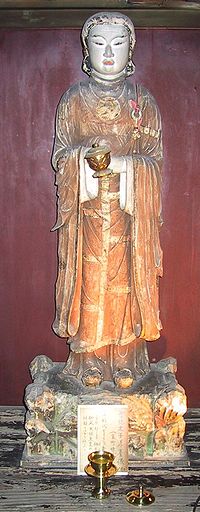Prince Shōtoku


Prince Shōtokunt (聖徳太子, Shōtoku Taishi) (574-622) was a regent and a politician of the Imperial Court in Japan.
According to the Nihon Shoki, Shotoku succeeded in establishing a centralized government during his reign. In 603, he established the twelve official ranks at court. The Seventeen-article constitution was promulgated, and is often attributed to Prince Shōtoku, though some scholars today doubt if he wrote this constitution, because of style. In 607, he sent a mission led by Ono no Imoko to the Sui Dynasty.
He was a proponent of Buddhism, and commissioned the Shitennoji Temple in Naniwa province (present-day Osaka). He was interested in mainland Asian cultures, particularly the Chinese culture.
He supported Hōryū-ji in Yamato province. The documents at Hōryū-ji claim it was founded by Suiko and Shōtoku in 607 but archeological facts don't support this claim.
He is our first written source for the name "Nihon" which the Japanese call their country today. In a letter to the Emperor of China, Yangdi, he wrote:
- "The Emperor of the land where Sun rises (nihon/hi iduru) sends a letter to the Emperor of the land where Sun sets. How are you doing?"
He is known by several titles and the real name is Umayado no ōji (厩戸皇子, literally the prince of the stable door) since he was born in front of a stable. He is also known as Toyosatomimi (豊聡耳) or Kamitsumiyaō (上宮王). In the Kojiki, his name appears as Kamitsumiya no Umayado no Toyosatomimi no Mikoto (上宮之厩戸豊聡耳命). In the Nihon Shoki, as well as Umayado no ōji, he is referred as 豊耳聡聖徳, 豊聡耳法大王, and 法主王. The most popular name Prince Shōtoku first appeared in Kaifūsō written in 751, more than a hundred years after his death.
His likeness has appeared on Japan's 10,000-, 5,000-, 1,000-, and 100-yen notes. He also supported Buddhism which made it even more famous and it was practiced alongside Shinto, the Japanese original religion
